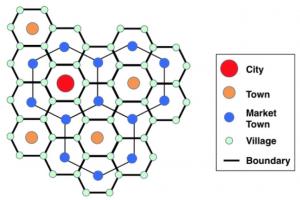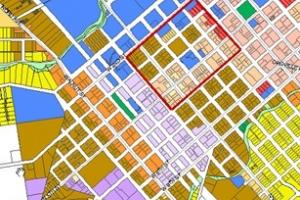Chrystaller Central Place Theory - Definition and Principles

Chrystaller Central Place Theory
Chrystaller Central Place Theory was first proposed in the 1930s by German geographer Walter Christaller, based on his studies of southern Germany.
- August Losch in Germany and Brian Berry and others in the U.S further developed concepts during the 1950s.
- The theory applies most clearly in regions such as the Great Plains, which are neither heavily industrialized nor interrupted by major physical features such as rivers or mountain ranges.
- Central Place Theory (CPT) is an attempt to explain the spatial arrangement, size, and number of settlements.
- In the flat landscape of southern Germany Chrystaller noticed that towns of a certain size were roughly equidistant.
- By examining and defining the functions of the settlement structure and the size of the hinterland he found it possible to model the pattern of settlement locations using geometric shapes.
Assumptions
Chrystaller made a number of assumptions such as:
All areas have:
- an isotropic (all flat) surface
- an evenly distributed population
- evenly distributed resources
- similar purchasing power of all consumers and consumers will patronize nearest market
- no excess profits (Perfect competition) consumers are of the same income level and same shopping behavior
- Uniform transport network that permitted direct travel from each settlement to the other
- Transport cost is proportional to distance traveled in example, the longer the distance travelled, the higher the transport cost
Explanation of some terms
Central Place:
A Central Place is a settlement which provides one or more services for the population living around it.
Low Order / High Order:
Simple basic services (e.g. grocery stores) are said to be of low order while specialized services (e.g. universities) are said to be of high order. Having a high order service implies there are low order services around it, but not vice versa.
Low Order Settlements:
Settlements which provide low order services are said to be low order settlements.
High Order Settlements:
Settlements that provide high order services are said to be high order settlements.
Sphere of Influence:
The sphere of influence is the area under influence of the Central Place.
Threshold:
Threshold the minimum population that is required to bring about the provision of certain good or services
Range of good or services:
Range of good or services -- the average maximum distance people will travel to purchase goods and services
Central Place Size and Spacing
Within the central place system, there are five sizes of communities. A hamlet is the smallest and is a rural community which is too small to be considered a village. The rank order of central places is:
- Hamlet
- Village
- Town
- City
- Regional Capital
The Chrystaller Central Place Theory has three orders or principles:
- The marketing principle: k=3
- The transportation principle: k=4
- The administrative principle: k=7
According to the marketing principle K = 3, the market area of a higher-order place(node) occupies 1/3rd of the market area of each of the consecutive lower size place(node) which lies on its neighbor. the lower size nodes (6 in numbers and 2nd larger circles) are located at the corner of a largest hexagon around the high-order settlement.
Each high-order settlement gets 1/3rd of each satellite settlement (which are 6 in total), thus K = 1 + 6×1/3 = 3. However, although in this K = 3 marketing network the distance traveled is minimized, the transport network is not the most efficient, because there is no intermediate transport links (network) between the larger places (nodes)
Marketing principle
- In this system, market areas at a certain level of the central place hierarchy are three times bigger than the next lowest one.
- The different levels then follow a progression of threes, meaning that as one moves through the order of places, the number of the next level goes up three times.
- For example, when there are two cities, there would be six towns, 18 villages, and 54 hamlets.
Marketing principle model
Transportation Principle
- According to K = 4 transport principle, the market area of a higher-order place includes a half of the market area of each of the six neighboring lower-order places, as they are located on the edges of hexagons around the high-order settlements.
- This generates a hierarchy of central places which results in the most efficient transport network.
- There are maximum central places possible located on the main transport routes connecting the higher order center.
- The transportation principle involves the minimization of the length of roads connecting central places at all hierarchy levels.
- In this system of nesting, the lower order centres are all located along the roads linking the higher order centres.
- This alignment of places along a road leads to minimization of road length.
- However, for each higher order center, there are now four centres of immediate lower order, as opposed to three centres under the marketing principle.

Administrative Principle
- Finally, the administrative principle (K=7) is the last system and here, the variation between the lowest orders and highest orders increase by a factor of seven. Here, the highest order trade area completely covers that of the lowest order, meaning that market serves a larger area.
Why are hexagons used in theory to delineate market areas?
- Circles are equidistant from center to edge, but they overlap or leave gaps.
- Squares nest together without gaps, but their sides are not equidistant from the center.
- Geographers use hexagons to depict the market area of a good or service, because hexagons offer a compromise between geometric properties of circles and squares.
Advantages
- Chrystaller Central Place Theory does a reasonably good job of describing the spatial pattern of urbanization. No other economic theory explains why there is a hierarchy of urban centers.
- The central place hierarchy provides a description of the relationship between a central place--higher order place--and its tributary areas--lower order places. Once this hierarchy is pointed out, anyone can see it.
- Central place theory does a good job of describing the location of trade and service activity. (It also does a good job of describing consumer market oriented manufacturing.)
Evaluation of Central-Place Theory
- The pattern of cities predicted by central place theory may not hold because of the failure to meet initial assumptions.
- Production costs may vary not only because of economies of scale but also by natural resource endowments (i.e. not a homogeneous plain)
- Transportation costs are not equal in all directions
- Rural markets (initially households) are not evenly distributed
- Non-economic factors (culture, politics, leadership) may be important but not evenly distributed
- Competitive practices may lead to freight absorption and phantom freight (other forms of imperfect competition)
Chrystaller's model will never be found in the real world because
- Large areas of flat land are rare, with the presence of relief barriers channeling transport in certain directions
- Government intervention can dictate the location of industry
- Perfect competition is unreal with some firms making more money than others.
- People vary their shopping trends, not always going to the nearest centre
- People or resources are never perfectly distributed
- Chrystaller envisaged each centre with a particular function whereas they have many which change over time
Losch's Central Place Theory
- The German economist August Lösch expanded on Chrystaller's work in his book The Spatial Organization of the Economy (1940
- In 1954, German economist August Losch modified Chrystaller Central Place Theory because he believed it was too rigid.
- He thought that Chrystaller's model led to patterns where the distribution of goods and the accumulation of profits were based entirely on location.
- He instead focused on maximizing consumer welfare and creating an ideal consumer landscape where the need to travel for any good was minimized and profits were held level, not maximized to accrue extra.










